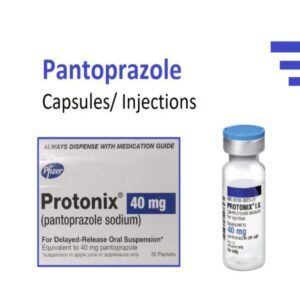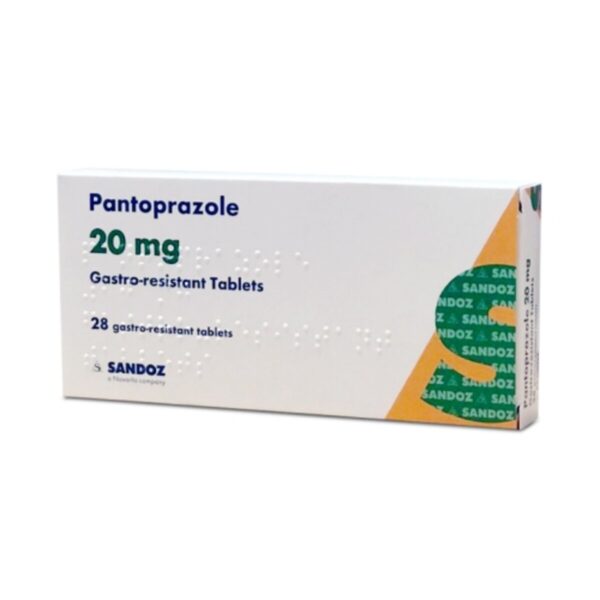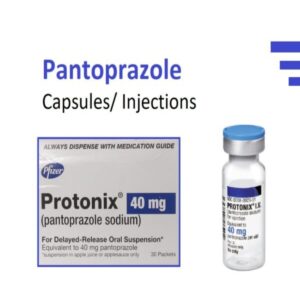- Description
- Additional Information
- Brand
- How To Use
- Product Details
- Side Effects
- Ingredients
- How to Store
- Patient Information leaflet
- Reviews (0)
- Questions & Answers
Pantoprazole 40mg Tablets, 28 Tablets
Pantoprazole 40mg Tablets provide effective relief of intense or severe acid-related disease symptoms such as heartburn, acid regurgitation and pain on swallowing associated with gastro-oesophageal reflux disease. Containing pantoprazole as the active ingredient, a selective proton pump inhibitor, Pantoprazole 40mg Tablets reduce the amount of acid produced in your stomach. This medication is suitable for adults and adolescents aged 12 years and above to treat acid-related diseases in both the stomach and intestine. Pantoprazole can also be used to prevent the return of reflux oesophagitis (inflammation of the oesophagus accompanied by regurgitation of stomach acid) and duodenal and stomach ulcers caused by non-steroidal anti-inflammatory drugs. Easily accessible, Pantoprazole 40mg Tablets offer fast and reliable action to help you combat your specific health needs. With effective symptom relief, this professional grade medication is an ideal choice for those suffering from long-term impacts of acid related diseases.
Pantoprazole Tablets can also be used to treat dogs, cats and other animals when prescribed by a vet.
Pantoprazole 40mg Tablets Reviews
After using Pantoprazole 40mg Tablets, it’s helpful to let others know about your experience. Reviews of an item help other users know that medicines received have helped the condition it is claimed for, how well the treatment worked or any issues to be aware of. We invite our users to leave a review of both their treatment and of the service provided. Click on the reviews tab to see if there has been feedback on this item.
What is the price of Pantoprazole 40mg Tablets?
The price of Pantoprazole 40mg Tablets is £9.99
Where can you buy Pantoprazole 40mg Tablets?
You can buy Pantoprazole 40mg Tablets at Dock Pharmacy Essex UK, UK Online Pharmacy.
Can you buy Pantoprazole 40mg Tablets Over the counter?
Pantoprazole 40mg Tablets is not available to buy over the counter. You need a prescription to buy Pantoprazole 40mg Tablets
| Brand | |
|---|---|
Brand
Pantoprazole
How To Use
How to take Pantoprazole
Always take this medicine exactly as your doctor or pharmacist has told you.
Check with your doctor or pharmacist if you are not sure.
Method of administration
Take the tablets 1 hour before a meal without chewing or breaking them and swallow them whole with some water.
Product Details
What you need to know before you take Pantoprazole
Do not take Pantoprazole – If you are allergic to pantoprazole or to any of the other ingredients of this medicine (listed in section 6). – If you are allergic to medicines containing other proton pump inhibitors. Warnings and precautions Talk to your doctor, pharmacist or nurse before taking Pantoprazole – If you have severe liver problems. Please tell your doctor if you have ever had problems with your liver in the past. Your doctor will check your liver enzymes more frequently, especially when you are taking Pantoprazole as a long-term treatment. In the case of a rise of liver enzymes the treatment should be stopped. 2 – If you need to take medicines called NSAIDs continuously and receive Pantoprazole because you have an increased risk of developing stomach and intestinal complications. Any increased risk will be assessed according to your own personal risk factors such as your age (65 years old or more), a history of stomach or duodenal ulcers or of stomach or intestinal bleeding. – If you have reduced body stores or risk factors for reduced vitamin B12 and receive long-term treatment with pantoprazole. As with all acid reducing agents, pantoprazole may lead to a reduced absorption of vitamin B12. – If you are taking HIV protease inhibitors such as atazanavir (for the treatment of HIV-infection) at the same time as pantoprazole, ask your doctor for specific advice. – Taking a proton pump inhibitor like pantoprazole, especially over a period of more than one year, may slightly increase your risk of fracture in the hip, wrist or spine. Tell your doctor if you have osteoporosis (reduced bone density) or if you have been told that you are at risk of getting osteoporosis (for example, if you are taking steroids). – If you are on Pantoprazole for more than three months it is possible that the levels of magnesium in your blood may fall. Low levels of magnesium can be seen as fatigue, involuntary muscle contractions, disorientation, convulsions, dizziness or increased heart rate. If you get any of these symptoms, please tell your doctor promptly. Low levels of magnesium can also lead to a reduction in potassium or calcium levels in the blood. Your doctor may decide to perform regular blood tests to monitor your levels of magnesium. – If you have ever had a skin reaction after treatment with a medicine similar to Pantoprazole that reduces stomach acid. – If you get a rash on your skin, especially in areas exposed to the sun tell your doctor as soon as you can, as you may need to stop your treatment with Pantoprazole. Remember to also mention any other ill-effects like pain in your joints. – If you are due to have a specific blood test (Chromogranin A). Tell your doctor immediately, before or after taking this medicine, if you notice any of the following symptoms, which could be a sign of another, more serious, disease: – An unintentional loss of weight – Vomiting, particularly if repeated – Vomiting blood; this may appear as dark coffee grounds in your vomit – You notice blood in your stools; which may be black or tarry in appearance – Difficulty in swallowing or pain when swallowing – You look pale and feel weak (anaemia) – Chest pain – Stomach pain – Severe and/or persistent diarrhoea, because this medicine has been associated with a small increase in infectious diarrhoea. Your doctor may decide that you need some tests to rule out malignant disease because pantoprazole also alleviates the symptoms of cancer and could cause delay in diagnosing it. If your symptoms continue in spite of your treatment, further investigations will be considered. If you take Pantoprazole on a long-term basis (longer than 1 year) your doctor will probably keep you under regular surveillance. You should report any new and exceptional symptoms and circumstances whenever you see your doctor. Children and adolescents Pantoprazole is not recommended for use in children as it has not been proven to work in children below 12 years of age. Other medicines and Pantoprazole 3 Tell your doctor or pharmacist if you are taking, have recently taken or might take any other medicines, including medicines obtained without a prescription. This is because Pantoprazole may influence the effectiveness of other medicines, so tell your doctor if you are taking: – Medicines such as ketoconazole, itraconazole and posaconazole (used to treat fungal infections) or erlotinib (used for certain types of cancer) because Pantoprazole may stop these and other medicines from working properly. – Warfarin and phenprocoumon, which affect the thickening, or thinning of the blood. You may need further checks. – Medicines used to treat HIV-infection, such as atazanavir. – Methotrexate (used to treat rheumatoid arthritis, psoriasis, and cancer) – if you are taking methotrexate your doctor may temporarily stop your Pantoprazole treatment because pantoprazole can increase levels of methotrexate in the blood. – Fluvoxamine (used to treat depression and other psychiatric diseases) – if you are taking fluvoxamine your doctor may reduce the dose. – Rifampicin (used to treat infections). – St John’s wort (Hypericum perforatum) (used to treat mild depression). Pregnancy and breast-feeding and fertility There are no adequate data from the use of pantoprazole in pregnant women. Excretion into human milk has been reported. If you are pregnant or breast-feeding, think you may be pregnant or are planning to have a baby, ask your doctor or pharmacist for advice before taking this medicine. You should use this medicine, only if your doctor considers the benefit for you greater than the potential risk for your unborn child or baby. Driving and using machines Pantoprazole has no or negligible influence on the ability to drive and use machines. If you experience side effects like dizziness or disturbed vision, you should not drive or operate machines. Pantoprazole contains sodium This medicine contains less than 1 mmol sodium (23 mg) per tablet, that is to say essentially ‘sodium-free’.
Side Effects
Possible side effects
Like all medicines, this medicine can cause side effects, although not everybody gets them. If you get any of the following side effects, stop taking these tablets and tell your doctor immediately, or contact the casualty department at your nearest hospital: – Serious allergic reactions (frequency rare: may affect up to 1 in 1,000 people): swelling of the tongue and/or throat, difficulty in swallowing, hives (nettle rash), difficulties in breathing, allergic facial swelling (Quincke’s oedema / angioedema), severe dizziness with very fast heartbeat and heavy sweating. – Serious skin conditions (frequency not known: frequency cannot be estimated from the available data): you may notice one or more of the following – blistering of the skin and rapid deterioration of your general condition, erosion (including slight bleeding) of eyes, nose, mouth/lips or genitals, or skin sensitivity/rash, particularly in areas of skin exposed to light/the sun. You may also have joint pain or flu-like symptoms, a fever, swollen glands (e.g. in the armpit) and blood tests may show changes in certain white blood cells or liver enzymes(Stevens-Johnson Syndrome, Lyell-Syndrome, Erythema multiforme, Subacute cutaneous lupus erythematosus, Drug reaction with eosinophilia and systemic symptoms(DRESS), Photosensitivity). – Other serious conditions (frequency not known: frequency cannot be estimated from the available data): yellowing of the skin or whites of the eyes (severe damage to liver cells, jaundice) 5 or fever, rash, and enlarged kidneyssometimes with painful urination, and lower back pain (serious inflammation of the kidneys), possibly leading to kidney failure. Other side effects are: – Common (may affect up to 1 in 10 people) Benign polyps in the stomach. – Uncommon (may affect up to 1 in 100 people) Headache; dizziness; diarrhoea; feeling sick, vomiting; bloating and flatulence (wind); constipation; dry mouth; abdominal pain and discomfort; skin rash, exanthema, eruption; itching; feeling weak, exhausted or generally unwell; sleep disorders; fracture in the hip, wrist or spine. – Rare (may affect up to 1 in 1,000 people) Distortion or complete lack of the sense of taste; disturbances in vision such as blurred vision; hives; pain in the joints; muscle pains; weight changes; raised body temperature; high fever; swelling of the extremities (peripheral oedema); allergic reactions; depression; breast enlargement in males. – Very Rare (may affect up to1 in 10,000 people) Disorientation. – Not known (frequency cannot be estimated from the available data) Hallucination, confusion (especially in patients with a history of these symptoms); feeling of tingling, prickling, pins and needles, burning sensation or numbness, rash, possibly with pain in the joints, inflammation in the large bowel, that causes persistent watery diarrhoea. Side effects identified through blood tests: – Uncommon (may affect up to 1 in 100 people) an increase in liver enzymes. – Rare (may affect up to 1 in 1,000 people) an increase in bilirubin; increased fat levels in blood; sharp drop in circulating granular white blood cells, associated with high fever. – Very Rare (may affect up to 1 in 10,000 people) a reduction in the number of blood platelets, which may cause you to bleed or bruise more than normal; a reduction in the number of white blood cells, which may lead to more frequent infections; coexisting abnormal reduction in the number of red and white blood cells, as well as platelets. – Not known (frequency cannot be estimated from the available data) decreased level of sodium, magnesium, calcium or potassium in blood (see section 2). Reporting of side effects If you get any side effects, talk to your doctor, pharmacist or nurse. This includes any possible side effects not listed in this leaflet. You can also report side effects directly via the Yellow Card Scheme. Website: www.mhra.gov.uk/yellowcard or search for MHRA Yellow Card in the Google Play or Apple App Store. By reporting side effects you can help provide more information on the safety of this medicine.
Ingredients
What Pantoprazole 40mg contains –
The active substance is pantoprazole. Each gastro-resistant tablet contains 40 mg of pantoprazole (as sodium sesquihydrate). –
The other ingredients are: Core: sodium carbonate (anhydrous), mannitol, crospovidone, povidone K90, calcium stearate. Coating: hypromellose, povidone K25, titanium dioxide (E171), yellow iron oxide (E172), propylene glycol, methacrylic acid-ethyl acrylate copolymer (1:1), polysorbate 80, sodium laurilsulfate, triethyl citrate. Printing ink: shellac, red, black and yellow iron oxide (E172), ammonia solution, concentrated.
How to Store
How to store Pantoprazole
Keep this medicine out of the sight and reach of children. Do not use this medicine after the expiry date which is stated on the carton and the container after EXP. The expiry date refers to the last day of that month. For bottles: Do not use tablets beyond 120 days after first opening of the bottle. This medicine does not require any special storage conditions.
Patient Information leaflet
Click here for the Patient Information leaflet
Please read before using the product
Only logged in customers who have purchased this product may leave a review.
Questions and answers of the customers
There are no questions yet, be the first to ask something for this product.
You Might Also Like
Original price was: £17.50.£14.50Current price is: £14.50.
Original price was: £17.50.£14.50Current price is: £14.50.
- Availability: in stock
Original price was: £14.50.£9.99Current price is: £9.99.
Original price was: £14.50.£9.99Current price is: £9.99.
- Availability: in stock
Original price was: £42.50.£38.30Current price is: £38.30.
PROTIUM INTRAVENOUS INJ. 40MG
Learn MoreOriginal price was: £42.50.£38.30Current price is: £38.30.
- Availability: in stock
£3.99 – £4.50
£3.99 – £4.50
- Availability: in stock
Original price was: £6.50.£5.50Current price is: £5.50.
Original price was: £6.50.£5.50Current price is: £5.50.
- Availability: in stock
Other Products From This Seller
Original price was: £31.00.£10.95Current price is: £10.95.
Chopard Wish Eau de Parfum 30ml Sweet and Oriental Fragrance for Women Indulge in elegance with Chopard Wish Eau de Parfum, 30ml, a sweet and oriental fragrance for women that exudes sophistication and charm. This luxurious scent by Chopard is inspired by the allure of wishes and dreams, blending warm and sensual notes for a […]
Learn MoreOriginal price was: £31.00.£10.95Current price is: £10.95.
- Availability: in stock
Original price was: £84.00.£26.95Current price is: £26.95.
Vera Wang Lovestruck Eau de Parfum 100ml Romantic Floral and Feminine Fragrance Celebrate romance and femininity with Vera Wang Lovestruck Eau de Parfum, 100ml, a romantic floral fragrance for women inspired by love at first sight. This enchanting scent captures the essence of passion and charm with a blend of delicate florals and sweet fruity […]
Learn MoreOriginal price was: £84.00.£26.95Current price is: £26.95.
- Availability: in stock
Original price was: £25.00.£9.95Current price is: £9.95.
Gloria Vanderbilt Vanderbilt EDT Spray, 100ml Timeless Floral Elegance Embrace timeless elegance with Gloria Vanderbilt Vanderbilt Eau De Toilette Spray, 100ml, a sophisticated floral fragrance for women that captures grace, femininity, and charm. Designed for confident and classic women, this iconic scent by Gloria Vanderbilt combines delicate floral notes with warm undertones for a long-lasting […]
Learn MoreOriginal price was: £25.00.£9.95Current price is: £9.95.
- Availability: in stock
Original price was: £34.00.£15.95Current price is: £15.95.
Elizabeth Arden Splendor Eau De Parfum, 125 ml Sophisticated Floral Fragrance Indulge in timeless elegance with Elizabeth Arden Splendor Eau De Parfum, 125ml, a sophisticated floral fragrance for women that exudes grace and charm. Inspired by moments of pure splendor, this iconic scent by Elizabeth Arden combines floral and woody notes for a captivating and […]
Learn MoreOriginal price was: £34.00.£15.95Current price is: £15.95.
- Availability: in stock
Original price was: £44.00.£19.95Current price is: £19.95.
Elizabeth Arden Red Door Eau De Toilette Spray 50ml Timeless Floral Elegance Step into timeless elegance with Elizabeth Arden Red Door Eau De Toilette Spray, 50ml, a classic floral fragrance for women that has become an icon of sophistication. Inspired by the legendary Red Door Spa, this luxurious scent captures the essence of femininity with […]
Learn MoreOriginal price was: £44.00.£19.95Current price is: £19.95.
- Availability: in stock
Original price was: £55.00.£19.95Current price is: £19.95.
Estee Lauder Pleasures EDP 30ml Fresh and Floral Fragrance for Women Experience the timeless elegance of Estee Lauder Pleasures Eau de Parfum, 30ml, a fresh and floral fragrance for women that captures the beauty of life’s simplest pleasures. This classic scent by Estee Lauder is designed for modern, sophisticated women who appreciate light, airy fragrances. […]
Learn MoreOriginal price was: £55.00.£19.95Current price is: £19.95.
- Availability: in stock
Original price was: £34.99.£19.95Current price is: £19.95.
Sarah Jessica Parker Lovely You Eau de Parfum Spray 100ml Sophisticated Floral and Musky Fragrance Step into timeless elegance with Sarah Jessica Parker Lovely You Eau de Parfum Spray, 100ml, a floral and musky fragrance for women that embodies sophistication and modernity. Created by Sarah Jessica Parker, this iconic scent celebrates femininity with a delicate […]
Learn MoreOriginal price was: £34.99.£19.95Current price is: £19.95.
- Availability: in stock
Original price was: £47.00.£29.95Current price is: £29.95.
Kenzo Flower Eau De Toilette Spray 30ml Fresh and Floral Fragrance for Women Experience the delicate beauty of nature with Kenzo Flower Eau De Toilette Spray, 30ml, a fresh and floral fragrance for women inspired by the elegance of the red poppy. This iconic scent combines floral and powdery notes to create a delicate and […]
Learn MoreOriginal price was: £47.00.£29.95Current price is: £29.95.
- Availability: in stock
Original price was: £47.00.£29.95Current price is: £29.95.
Jimmy Choo Eau de Parfum 40ml Sweet and Floral Fragrance for Women Step into a world of luxury and confidence with Jimmy Choo Eau de Parfum, 40ml, a sweet and floral fragrance for women that embodies modern glamour. Designed for women who exude confidence and style, this Jimmy Choo perfume for women blends fruity and […]
Learn MoreOriginal price was: £47.00.£29.95Current price is: £29.95.
- Availability: in stock
Original price was: £52.00.£23.95Current price is: £23.95.
Issey Miyake L’Eau d’Issey Pure Nectar Eau de Parfum Spray, 30ml Floral and Aquatic Elegance Discover the purity of nature with Issey Miyake L’Eau d’Issey Pure Nectar Eau de Parfum Spray, 30ml, a floral and aquatic fragrance for women that encapsulates elegance and sophistication. This Issey Miyake perfume for women combines fresh and delicate notes […]
Learn MoreOriginal price was: £52.00.£23.95Current price is: £23.95.
- Availability: in stock



















Reviews
There are no reviews yet